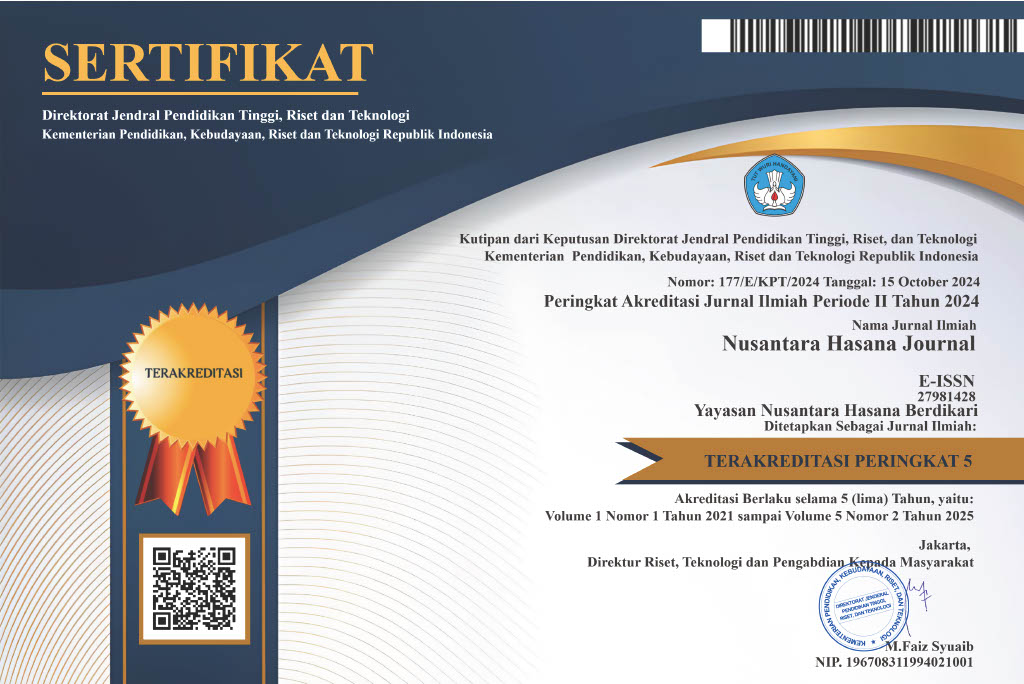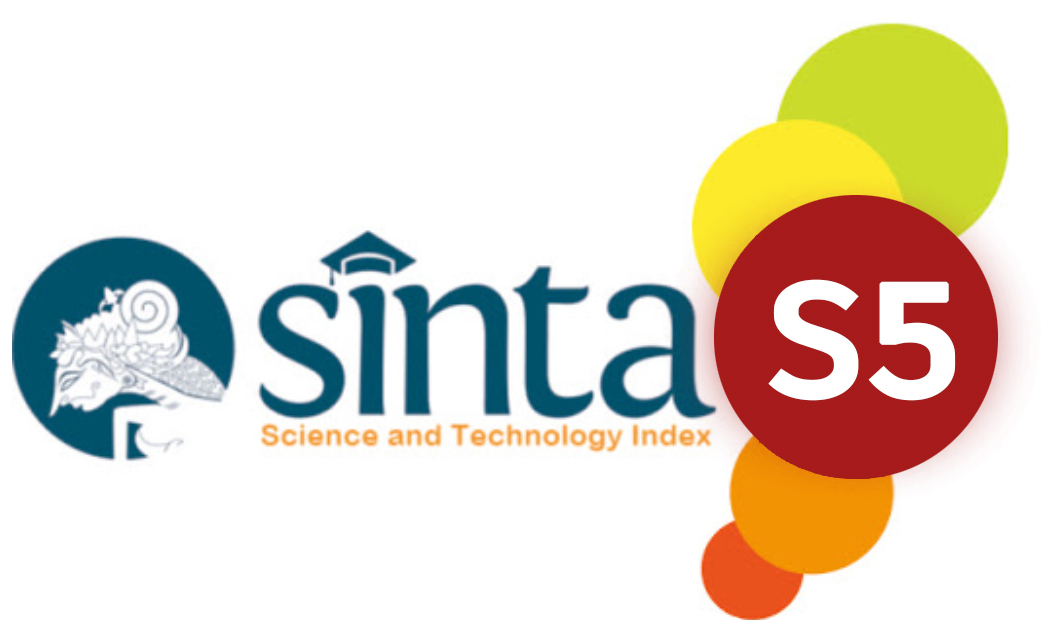PENINGKATAN RESIKO PRESBIKUSIS PADA PASIEN LANSIA HIPERTRIGLISERIDEMIA DI RSI SITI RAHMAH
DOI:
https://doi.org/10.59003/nhj.v4i7.1347Keywords:
presbycusis, hypertriglyceridemia, triglyceride, dyslipidemia, elderlyAbstract
Background: Presbycusis is a sensorineural hearing disorder that causes loss of hearing ability in old age. Dyslipidemia is a risk factor for presbycusis, namely an imbalance in lipids such as cholesterol, LDL, triglycerides and HDL. Excessive triglyceride levels will increase the risk of atherosclerosis. The formation of atherosclerotic plaque will result in thickening of the blood vessel walls and narrowing of the lumen, resulting in obstruction of blood flow and reducing oxygen transport which can cause ischemia in the cochlea and disrupt hearing function. Objective: Determine the relationship between increased triglyceride levels and presbycusis in elderly patients with dyslipidemia at RSI Siti Rahmah. Method: This type of research is analytical observational research using a case control design and the type of data used is primary and secondary data using consecutive sampling techniques. Results: Presbycusis was most commonly found in the 60-69 year age group (58,33%), presbycusis was mostly found in dyslipidemia elderly with increased triglyceride levels (75.0%), and the highest grouping of triglyceride levels was found in the high group (41,67%). There is a significant relationship between triglyceride levels in elderly patients with dyslipidemia and the incidence of presbycusis (P-value 0.001) and the OR calculation shows that elderly people with dyslipidemia with increased triglyceride levels are 6 times more at risk of experiencing presbycusis compared to elderly people without dyslipidemia. Conclusion: There is a significant relationship between increasing triglyceride levels and presbycusis in elderly with dyslipidemia at RSI Siti Rahmah
Downloads
References
J. Chester et al., “A review on recent advancement on age-related hearing loss: The applications of nanotechnology, drug pharmacology, and biotechnology,” Pharmaceutics, vol. 13, no. 7. 2021, doi: 10.3390/pharmaceutics13071041.
S. K. Manche, M. Jangala, P. Putta, R. M. Koralla, and J. Akka, “Association of oxidative stress gene polymorphisms with presbycusis,” Gene, vol. 593, no. 2, 2016, doi: 10.1016/j.gene.2016.08.029.
J. Guerra, V. Naidoo, and R. Cacabelos, “Genomics and Pharmacogenomics of Age-related Hearing Loss,” Curr. Pharmacogenomics Person. Med., vol. 18, no. 2, 2021, doi: 10.2174/1875692118666210823115347.
E. Tavanai and G. Mohammadkhani, “Role of antioxidants in prevention of age-related hearing loss: a review of literature,” European Archives of Oto-Rhino-Laryngology, vol. 274, no. 4. 2017, doi: 10.1007/s00405-016-4378-6.
N. Watson, B. Ding, X. Zhu, and R. D. Frisina, “Chronic inflammation - inflammaging - in the ageing cochlea: A novel target for future presbycusis therapy,” Ageing Res. Rev., vol. 40, pp. 142–148, Nov. 2017, doi: 10.1016/J.ARR.2017.10.002.
I. Triansyah, A. Darmayati, and D. P. Sari, “Peningkatan Kejadian Presbikusis Pada Lansia Hipertensi di Puskesmas Kurai Taji Pariaman Tahun 2021,” Nusant. Hasana J., vol. 2, no. 1, 2022, Accessed: Sep. 22, 2022. [Online]. Available: http://nusantarahasanajournal.com/index.php/nhj/article/view/354.
P. T. Mick et al., “Associations Between Cardiovascular Risk Factors and Audiometric Hearing: Findings From the Canadian Longitudinal Study on Aging,” Ear Hear., vol. 44, no. 6, 2023, doi: 10.1097/AUD.0000000000001370.
M. Taneja, “Presbycusis,” Indian Journal of Otology, vol. 27, no. 3. 2021, doi: 10.4103/indianjotol.indianjotol_165_21.
H. Anil and Shazia, “A Study of Relationship between Serum Lipids and Sensorineural Hearing Loss,” 2016, doi: 10.18535/jmscr/v4i7.65.
R. Sharma et al., “Relationship Between Lipid Profile and Sensorineural Hearing Loss: An Institution Based Study,” Indian J. Otolaryngol. Head Neck Surg., vol. 75, 2023, doi: 10.1007/s12070-022-03328-2.
S. Silky et al., “A Study of Relationship Between Serum Lipids and Sensorineural Hearing Loss,” Indian J. Otolaryngol. Head Neck Surg., vol. 75, no. 1, pp. 578–583, Apr. 2023, doi: 10.1007/S12070-023-03657-W/METRICS.
I. G. N. A. D. Putra, “GAMBARAN AUDIOMETRI NADA MURNI PASIEN PRESBIKUSIS DI POLI THT-KL RSUP SANGLAH DENPASAR,” E-Jurnal Med. Udayana, vol. 12, no. 10, pp. 78–82, Nov. 2023, doi: 10.24843/MU.2023.V12.I10.P13.
M. M. Ario, Ratna Anggraeni, and Nur A Aroeman, “Karakteristik Penderita Presbikusis di Kota Bandung Tahun 2019,” J. Med. Heal., vol. 4, no. 1, 2022.
N. K. Ratih Nuryadi, M. Wiranadha, and W. Sucipta, “Karakteristik pasien presbikusis di Poliklinik THT-KL RSUP Sanglah Denpasar tahun 2013-2014,” Med. J., vol. 48, no. 1, p. 58, Jul. 2017, doi: 10.15562/MEDICINA.V48I1.27.
R. Mudhol and A. Patwegar, “Lipid Profile in Patients with Sensorineural Hearing Loss - One Year Observational Study in a Tertiary Care Centre,” Madridge J. Otorhinolaryngol., vol. 4, no. 1, 2019, doi: 10.18689/mjol-1000116.
H. S. Rim et al., “Association of metabolic syndrome with sensorineural hearing loss,” J. Clin. Med., vol. 10, no. 21, 2021, doi: 10.3390/jcm10214866.
F. Salimi and F. Mohammadipanah, “Nanomaterials Versus The Microbial Compounds With Wound Healing Property,” Front. Nanotechnol., vol. 2, no. January, pp. 1–17, 2021, doi: 10.3389/fnano.2020.584489.
L. P. Rolim et al., “Effects of diabetes mellitus and systemic arterial hypertension on elderly patients’ hearing,” Braz. J. Otorhinolaryngol., vol. 84, no. 6, 2018, doi: 10.1016/j.bjorl.2017.08.014.
J. Aghazadeh-Attari, B. Mansorian, M. Mirza-Aghazadeh-Attari, J. Ahmadzadeh, and I. Mohebbi, “Association between metabolic syndrome and sensorineural hearing loss: A cross-sectional study of 11,114 participants,” Diabetes, Metab. Syndr. Obes., vol. 10, 2017, doi: 10.2147/DMSO.S150893.
B. R. Santoso, E. E. M. Gaghauna, and R. Raihana, “Trygliceride and Total Cholesterol level as the predictor of mortality in stroke patient: Literature Review,” J. Heal., vol. 10, no. 1, 2023, doi: 10.30590/joh.v10n1.459.
E. K. Speliotes, M. Balakrishnan, L. S. Friedman, and K. E. Corey, “Treatment of Dyslipidemia in Common Liver Diseases,” Clinical Liver Disease, vol. 14, no. 5. 2019, doi: 10.1002/cld.876.
C. Wu, D. A. Okar, J. Kang, and A. J. Lange, “Reduction of hepatic glucose production as a therapeutic target in the treatment of diabetes,” Curr. Drug Targets Immune, Endocr. Metab. Disord., vol. 5, no. 1, pp. 51–59, 2005, doi: 10.2174/1568008053174769.
S. Jamesdaniel, R. Rosati, J. Westrick, and D. M. Ruden, “Chronic lead exposure induces cochlear oxidative stress and potentiates noise-induced hearing loss,” Toxicol. Lett., vol. 292, pp. 175–180, Aug. 2018, doi: 10.1016/J.TOXLET.2018.05.004.
M. Safitri, E. Nurfarihah, and M. Handini, “Kualitas Hidup Penderita Presbikusis di RSUD Sultan Syarif Mohamad Alkadrie Pontianak tahun 2019,” Cermin Dunia Kedokt., vol. 49, no. 1, 2022, doi: 10.55175/cdk.v49i1.178.
Downloads
Published
How to Cite
Issue
Section
License
Copyright (c) 2024 Elsa Ardana

This work is licensed under a Creative Commons Attribution-NonCommercial-ShareAlike 4.0 International License.
NHJ is licensed under a Creative Commons Attribution-NonCommercial-ShareAlike 4.0 International License.
Articles in this journal are Open Access articles published under the Creative Commons CC BY-NC-SA License This license permits use, distribution and reproduction in any medium for non-commercial purposes only, provided the original work and source is properly cited.
Any derivative of the original must be distributed under the same license as the original.
























